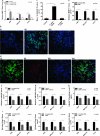Helicobacter pylori potentiates epithelial:mesenchymal transition in gastric cancer: links to soluble HB-EGF, gastrin and matrix metalloproteinase-7
- PMID: 20584780
- PMCID: PMC2976077
- DOI: 10.1136/gut.2009.199794
Helicobacter pylori potentiates epithelial:mesenchymal transition in gastric cancer: links to soluble HB-EGF, gastrin and matrix metalloproteinase-7
Abstract
Background and aims: Helicobacter pylori (H pylori) infection is a major risk factor in the development of distal gastric adenocarcinoma. Development of the invasive phenotype is associated with the phenomenon of epithelial:mesenchymal transition (EMT). Soluble heparin-binding epidermal growth factor (HB-EGF) has been implicated in this process. A study was undertaken to investigate the possibility that matrix metalloproteinase (MMP)-7 is upregulated in H pylori infection as a result of hypergastrinaemia, which may enhance shedding of HB-EGF and contribute towards EMT in gastric adenocarcinoma cell lines.
Methods: Three gastric epithelial cell lines (AGS, MGLVA1 and ST16) were co-cultured with the pathogenic H pylori strain 60190 and non-pathogenic strain Tx30a in an in vitro infection model. Gene expression was quantified by real-time PCR, HB-EGF shedding by ELISA and protein expression by immunofluorescence or immunohistochemistry. The INS-GAS mouse, a transgenic mouse model of gastric carcinogenesis which overexpresses amidated gastrin, was used to investigate the in vivo relationship between HB-EGF, MMP-7, gastrin and EMT.
Results: The pathogenic strain of H pylori significantly upregulated EMT-associated genes Snail, Slug and vimentin in all three gastric cell lines to a greater degree than the non-pathogenic strain. Pathogenic H pylori also upregulated HB-EGF shedding, a factor implicated in EMT, which was partially dependent on both gastrin and MMP-7 expression. Gastrin and MMP-7 siRNAs and MMP-7 neutralising antibody significantly reduced upregulation of HB-EGF shedding in H pylori infected gastric cell lines and reduced EMT gene expression. The effect of H pylori on EMT was also reversed by gastrin siRNA. Neutralisation of gastrin in the INS-GAS mouse model reduced expression of MMP-7, HB-EGF and key EMT proteins.
Conclusion: The upregulation of MMP-7 by pathogenic H pylori is partially dependent on gastrin and may have a role in the development of gastric cancer, potentially through EMT, by indirectly increasing levels of soluble HB-EGF.
Conflict of interest statement
Figures





Similar articles
-
Helicobacter pylori-Induced HB-EGF Upregulates Gastrin Expression via the EGF Receptor, C-Raf, Mek1, and Erk2 in the MAPK Pathway.Front Cell Infect Microbiol. 2018 Jan 15;7:541. doi: 10.3389/fcimb.2017.00541. eCollection 2017. Front Cell Infect Microbiol. 2018. PMID: 29379775 Free PMC article.
-
Helicobacter pylori can induce heparin-binding epidermal growth factor expression via gastrin and its receptor.Cancer Res. 2006 Aug 1;66(15):7524-31. doi: 10.1158/0008-5472.CAN-05-3246. Cancer Res. 2006. PMID: 16885350
-
Increased expression of the urokinase plasminogen activator system by Helicobacter pylori in gastric epithelial cells.Am J Physiol Gastrointest Liver Physiol. 2008 Sep;295(3):G431-41. doi: 10.1152/ajpgi.90283.2008. Epub 2008 Jul 3. Am J Physiol Gastrointest Liver Physiol. 2008. PMID: 18599586 Free PMC article.
-
Mechanisms of the Epithelial-Mesenchymal Transition and Tumor Microenvironment in Helicobacter pylori-Induced Gastric Cancer.Cells. 2020 Apr 23;9(4):1055. doi: 10.3390/cells9041055. Cells. 2020. PMID: 32340207 Free PMC article. Review.
-
Helicobacter pylori infection, gastrin and cyclooxygenase-2 in gastric carcinogenesis.World J Gastroenterol. 2014 Sep 28;20(36):12860-73. doi: 10.3748/wjg.v20.i36.12860. World J Gastroenterol. 2014. PMID: 25278683 Free PMC article. Review.
Cited by
-
A role for the epidermal growth factor receptor signaling in development of intestinal serrated polyps in mice and humans.Gastroenterology. 2012 Sep;143(3):730-740. doi: 10.1053/j.gastro.2012.05.034. Epub 2012 May 26. Gastroenterology. 2012. PMID: 22643351 Free PMC article.
-
Exploring the Role of the Gut and Intratumoral Microbiomes in Tumor Progression and Metastasis.Int J Mol Sci. 2023 Dec 6;24(24):17199. doi: 10.3390/ijms242417199. Int J Mol Sci. 2023. PMID: 38139030 Free PMC article. Review.
-
EGF-reduced Wnt5a transcription induces epithelial-mesenchymal transition via Arf6-ERK signaling in gastric cancer cells.Oncotarget. 2015 Mar 30;6(9):7244-61. doi: 10.18632/oncotarget.3133. Oncotarget. 2015. PMID: 25779663 Free PMC article.
-
Role of the epithelial barrier in intestinal fibrosis associated with inflammatory bowel disease: relevance of the epithelial-to mesenchymal transition.Front Cell Dev Biol. 2023 Sep 26;11:1258843. doi: 10.3389/fcell.2023.1258843. eCollection 2023. Front Cell Dev Biol. 2023. PMID: 37822869 Free PMC article. Review.
-
Helicobacter pylori-Induced HB-EGF Upregulates Gastrin Expression via the EGF Receptor, C-Raf, Mek1, and Erk2 in the MAPK Pathway.Front Cell Infect Microbiol. 2018 Jan 15;7:541. doi: 10.3389/fcimb.2017.00541. eCollection 2017. Front Cell Infect Microbiol. 2018. PMID: 29379775 Free PMC article.
References
-
- Starzynska T, Malfertheiner P. Helicobacter and digestive malignancies. Helicobacter 2006;11(Suppl 1):32–5 - PubMed
-
- Watson SA, Grabowska AM, El-Zaatari M, et al. Gastrin-active participant or bystander in gastric carcinogenesis? Nat Rev Cancer 2006;6:936–46 - PubMed
-
- Huang JQ, Zheng GF, Sumanac K, et al. Meta-analysis of the relationship between cagA seropositivity and gastric cancer [see comment]. Gastroenterology 2003;125:1636–44 - PubMed
-
- Schlessinger J, Schlessinger J. Common and distinct elements in cellular signaling via EGF and FGF receptors. Science 2004;306:1506–7 - PubMed
MeSH terms
Substances
Grants and funding
LinkOut - more resources
Full Text Sources
Medical
Research Materials
